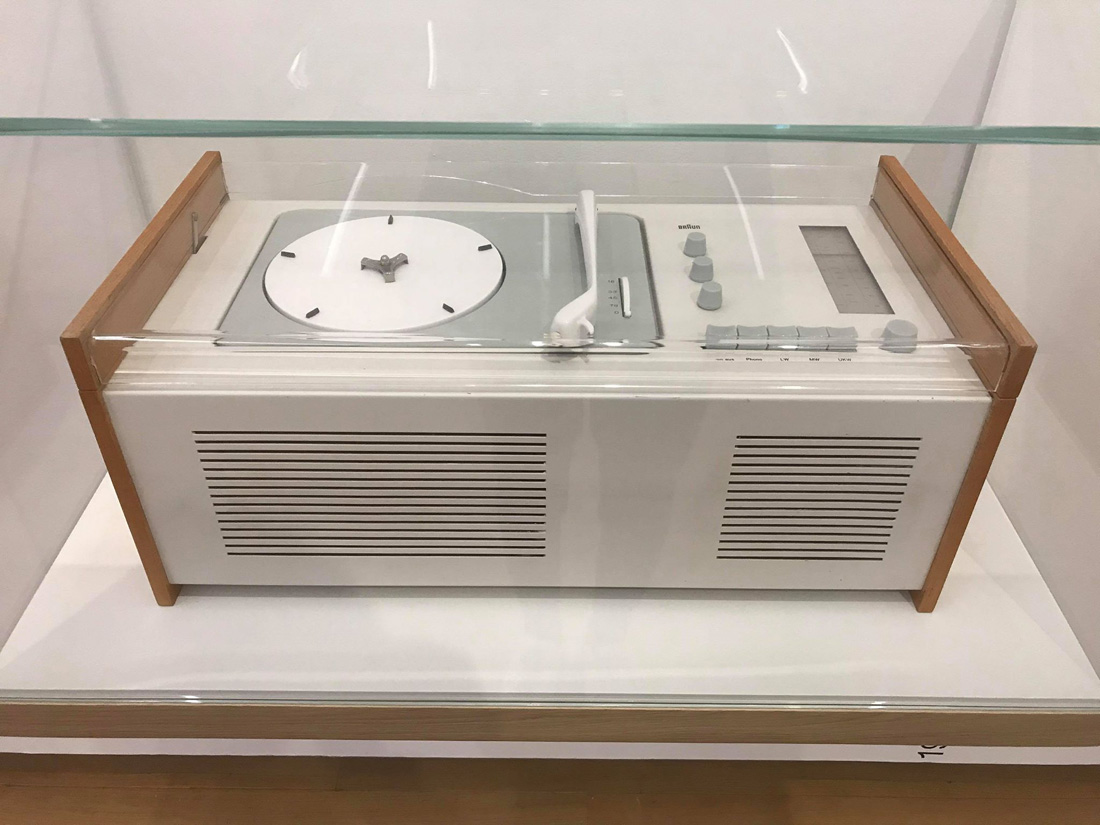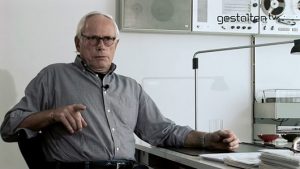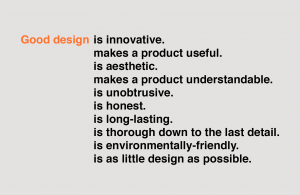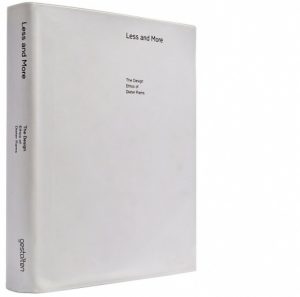I was startled by the fresh, sleek but subtle apparence of the SK 4 as I walked by it in the basement of the Stedelijk museum. I stopped and bent over to get a closer look. This audio system combines a turntable and a radio with two speakers in a single white metal box ornamented solely by two wooden boards on each side and an acrylic glass lid. The rest is all functional: a few plastic control knobs and an analog display for radio frequencies.
« Hans Gugelot, Dieter Rams » stated the label on the right.
Those two designers (Hans Gugelot and Dieter Rams) worked for electrical appliance company Braun which released the Phonosuper SK 4 in 1956 as one of the first products to incarnate their new design. They wanted to get rid of the superficial and fashionable to make room for efficiency, simplicity and the beauty that comes with it.
I started searching the internet for some historical context and information about the relevancy of the object today. A few scrolls were enough to realize how influential the SK 4 design is. I first stumbled on countless ads selling the product from one to three thousand euros. Then I found many blogs paying tribute to it by sharing images and information about the design philosophy of the brand. I noticed that Dieter Rams was a lot more mentioned and appreciated than his co-worker Hans Gugelot, probably because the former was involved with Braun for many years (and still is) and has worked on many other notorious products. In fact, Rams is a legend of product design, referenced by many younger designers, such as Apple’s Jony Ive, as a major influence. This is very apparent when looking at today’s electronic products like smartphones, computers, bluetooth speakers but also furnitures and architectural edifices. I found a short documentary on Vimeo yielding the floor to Mr Rams himself at the initiative of the V&A Museum in London. According to him, his willingness to bring a new world of modern design to post-war Germany began when he met the Braun brothers. The success of their new creative approach proved the importance of a well though and original design. He also developed the 10 commandments for good design (which undoubtedly still hold up) in order to teach the students and the media, as well as keep together the behavior of the brand.
I searched the library of the Rietveld Academie as well as the library of the Stedelijk museum for documents published in the 60’s when the SK 4 was commercialized but I was not able to find any. All I could find were recent books paying tributes to the design philosophy of Braun and Dieter Rams, compiling images and information on their broad collection of products. I did not learn anything new about the SK 4 except for a few drawings I found in the book ‘Less and More, the Design Ethos of Dieter Rams’ by Klaus Klemp. They were made by Rams during the conception of the audio system, which I was quite excited about. The drawings are very simple, almost innocent, and denote of the « new beginning » state of mind of their author. It only made me thirsty for more archive documents of this type, so I kept on researching the internet. I found an image from an original Braun catalog including the SK 4, as well as a diagram of the SK 4 electric circuits naming the object « schneewittchensarg » (« snow white coffin »). This nickname shows how groundbreaking the design of the SK 4 was.
Overall, I found the internet much more efficient for my researches: it brought me more information in a shorter amount of time then books did. Nonetheless, the search for material publications is much more thrilling. It leads to discovering new places (like the archives of the Stedelijk museum) and offers a tactile, more intimate experience. The books I found did not really offer more information but displayed in a more interesting, compelling and memorable way. This leads me to thinking that printed publications will continue to play a very important role along the exponential growth of virtual data. Our senses have not changed and the book is a design object which offers a cleaner and purer visual and tactile experience than computers.






